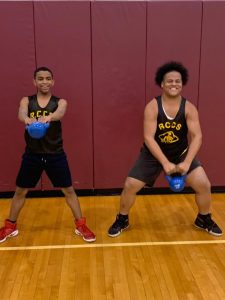Daily Physical Education
A quality PE program that meets national guidelines is the cornerstone for a physically active school and helps support improved classroom behavior, physical fitness, and standardized test scores.
Read More Fitness testing is a great way to monitor and assess students’ ability as it relates to aerobic fitness, strength, and flexibility. It can also help students understand how healthy they are and learn to set goals to improve their health-related fitness.
Fitness testing is a great way to monitor and assess students’ ability as it relates to aerobic fitness, strength, and flexibility. It can also help students understand how healthy they are and learn to set goals to improve their health-related fitness.
There are two types of fitness: Health-related fitness and skill-related fitness. Health-related fitness and includes aerobic capacity, muscular endurance, muscular strength, flexibility and body composition. Skill-related fitness refers to abilities such as speed, reaction time, agility, balance, coordination and power.
One of the most popular fitness testing programs for schools is the Presidential Youth Fitness Program (PYFP). The Presidential Youth Fitness Program helps schools achieve excellence in physical education through quality fitness education and assessment practices by providing tools to: teach fitness concepts, assess fitness and understand results, plan for improvement or maintenance of fitness levels and empower students to be fit and active for life. Registration is free, and gives you access to members-only free resources. PYFP assesses student health-related fitness, which may be an indicator of health or health risks in young people. PYFP supports health-related fitness assessments and offers not only the assessment but instructional and communication strategies for physical educators and recognition mechanisms for fitness and physical activity achievements.
Regardless of the fitness assessment program you use, fitness testing is an essential element of a strong physical education program. Take action with some of these strategies to start fitness testing at your school.
Activities such as these help students explore…
Self-Management: Discussing fitness testing to assess personal fitness goals helps students assess and understand the results of self-discipline and hard work in PE. Because fitness testing is such a personal aspect of PE, it allows students to better understand their physical strengths and areas of growth while setting goals to become healthier and stronger.
Responsible Decision-Making: Fitness testing allows students to evaluate where they are in the current moment and plan where they want to be in the future. Responsible decision-making leads to greater results. This supports students in being mindful of setting and practicing healthy habits and learning to identify solutions for continued success and betterment.
Fitness testing data should not be used to evaluate physical educators’ effectiveness or to grade students on their performance.
Inform students and parents at least one week before fitness testing will take place.
Minimize competition during fitness testing. Testing should be individual and all students should be given the same fitness test to ensure reliability.
Try to eliminate other students watching or observing a student’s fitness test. This can help minimize any anxiety from students about their results being shared with their peers.
Consider rewarding students after post testing to congratulate them on their accomplishments. Ensure that this recognition is non-food related.
For more activities and ideas like this one, be sure to sign up for our news and updates. And if you like what you see, please donate to support our work creating more ways to help build a healthier future for kids.
Categories: Physical Activity & Play, At School, Digital Resource